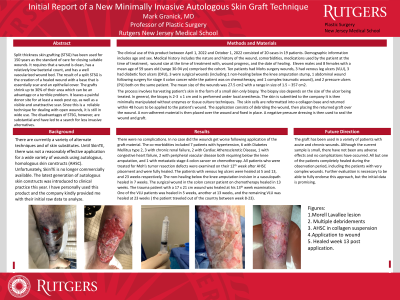Clinical Research
(CR-021) Safety and Efficacy of a new Autologous Homologous Skin Construct
Friday, April 28, 2023
7:15 PM - 8:30 PM East Coast USA Time

Introduction: Split thickness skin grafting (STSG) has been used for 150 years as the standard of care for closing suitable wounds. It requires that a wound is clean, has a relatively low bacterial count, and has a well vascularized wound bed. The result of a split STSG is a painful donor site which develops a discolored scar. The wound heals with dense contracted scar with a meshed appearance if the graft is meshed. The disadvantages of STSG are substantial and have led to a search for less invasive alternatives. There are a variety of alternate techniques and skin substitutes. An early Autologous Homologous Skin Construct (AHSC) was developed and shown to be highly effective for treating a wide variety of acute and chronic wounds in multiple studies. That product is no longer available. The latest generation of AHSC has recently been introduced. Skin is harvested, sent to the company, reformatted, placed into viscous collagen, and returned for application in 48 hours.
Methods: A retrospective review was performed including all patients who have healed in less than 12 weeks or who have had the treatment with 12 or more weeks follow up. Eleven male and 8 female patients (ages 30-94 years old) had treatment of 21 diverse acute and chronic wounds.
Results: There were no complications and in no case did the wounds worsen. The co-morbidities include hypertension, diabetes mellitus, chronic renal failure, cardiac atherosclerotic disease, congestive heart failure, peripheral vascular disease, below the knee amputations (BKA), and metastatic colon cancer on chemotherapy. Ten wounds were healed within 12 weeks, 3 healed by 13 weeks, 1 each by 18 and 23 (patient was unevaluated 8-23 weeks) weeks. Only 1 wound, last seen at 12 weeks, was unhealed, although 15% smaller.
Discussion: Although the current sample is small, the cohort includes a wide range of acute and chronic wounds. There have not been any adverse effects and no complications. Based on this initial experience, this AHSC appears to be safe and highly effective and warrants further investigation.
Methods: A retrospective review was performed including all patients who have healed in less than 12 weeks or who have had the treatment with 12 or more weeks follow up. Eleven male and 8 female patients (ages 30-94 years old) had treatment of 21 diverse acute and chronic wounds.
Results: There were no complications and in no case did the wounds worsen. The co-morbidities include hypertension, diabetes mellitus, chronic renal failure, cardiac atherosclerotic disease, congestive heart failure, peripheral vascular disease, below the knee amputations (BKA), and metastatic colon cancer on chemotherapy. Ten wounds were healed within 12 weeks, 3 healed by 13 weeks, 1 each by 18 and 23 (patient was unevaluated 8-23 weeks) weeks. Only 1 wound, last seen at 12 weeks, was unhealed, although 15% smaller.
Discussion: Although the current sample is small, the cohort includes a wide range of acute and chronic wounds. There have not been any adverse effects and no complications. Based on this initial experience, this AHSC appears to be safe and highly effective and warrants further investigation.

.png)